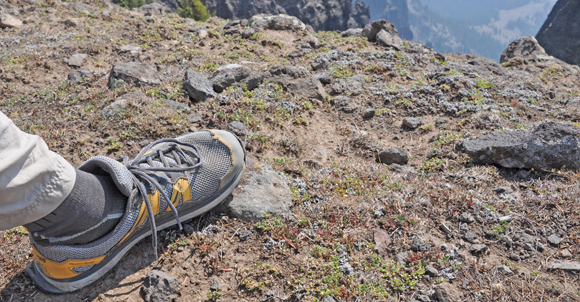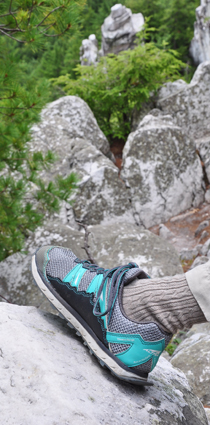April 21, 2014. Do your feet a favor and they’ll pay you back many times over. Every time you take them for a hike.
I’ve hiked all over the world. I’ve seen carefree mountain goats move easily and gracefully in very precarious places. Without hiking boots or walking sticks. I’ve been envious.
I lost my old goat envy when I found these new-style hiking shoes. They’re light. They’re completely comfortable. And they make me very, very sure-footed. Balanced and steady on any terrain. If you’ve been avoiding adventurous trails for fear of falling or tiring, you should try these.
I hesitate to tell you or anybody else what to wear. On your feet or any other body parts. It’s a little too personal. But I’ve just had such good experiences with these Altra Lone Peak mountain shoes I thought I should let you know about them. Because I know you’re more likely to hit the trail when you’re comfortable and confident about having an easy hike. And because the American College of Sports Medicine just revised its recommendations for good, safe running shoes to describe the ones I wear.
On the rocks. In the mud.
These shoes gave me the most comfortable serious hiking I’ve ever done. On steep, boulder-strewn stretches of the Appalachian Trail in Massachusetts. On sheer rock and loose sand surfaces in Yellowstone National Park.
No toe bruises. No sore hips or knees. On ten- and twenty-mile hikes with serious elevation gain, my calves and Achilles felt like they were working hard while on the trail, but zero soreness or tightness the next day.
How do these shoes make me and my feet so happy to hike? They’re shaped like feet and they have flat heels. Non-elevated heels that keep me on my toes and prevent me from leaning back and slipping. I don’t fall a lot, but when I do, I fall down, not up. It’s only happened hiking downhill, when an elevated boot heel lands hard and pitches me forward. To compensate, I lean backward. Lean too far back and your feet fly out from under you and you’re sitting on the trail. Or a rock.
More important, these shoes also have a very wide “toe box”. That’s the front of the shoe. It’s actually foot-shaped: designed to let your toes spread out, naturally and comfortably. So they actually work like toes. Ten little stabilizers that are amazingly good at keeping you balanced. Especially on the way back down the mountain.
I’m not going to enter any mountain goat competitions, but I really appreciated the lightness and flexibility of the shoe and the agility they allow when you’re on a rocky New England trail like the Appalachian Trail. In traditional hiking shoes and boots, I always felt like my feet were in narrow boxes with flat, rigid bottoms and sides. Box-shaped, not foot-shaped. So I always felt flat-footed, teetering on the top of each and every rock and boulder I stepped on. With the Lone Peaks, I feel like I’m hopping from stone to stone. With the greatest of ease.
They’re very light, as close as you can get to barefoot hiking without destroying your soles. One of the layers in the shoe’s cushioned bottom is called “Stoneguard”. I don’t know what it’s made from, but when you step on a sharp rock edge with your mid-foot, there’s no “ouch”.
Kathy was worried about the shoe’s lack of ankle support. But she did a wicked steep and long hike in Yellowstone in total comfort. Her first hike in years without hiking boots rubbing blisters into her ankles and toes. Most important, no turned, twisted or sprained ankles. No sense of instability. Because the shoes let her toes stabilize her every step of the way. The old-fashion way. Letting her feet do what thousands of years of human evolution have led them to do. Without outside help. Like Altra’s running shoes, the big toe box liberates your toes to spread out and do what they do best: balance and stabilize you.
When you’re going up a steep slope, your non-elevated heel means your Achilles and calves get a serious stretch, so do some Calf-rocking and Calf Stretches to prepare. Using your calves more means less work for your quads and hamstrings. Which you’ll really appreciate on the way back down. Happy trails to you.
And Happy National Parks Week. This week, they’re all free. Here in the U.S., free admission to every national park all week. Get out there. Or plan to get out there. Free now. Cheaper later.
Lone Peak trail shoes for women
Lone Peak trail shoes for men
A Brief History of Foot Happiness
For about 10,000 years, we humans ran and hiked without Nikes and other shoes engineered to cushion and correct foot movement. Evolutionary biologists tell us that, before the invention of spears, the ability to outrun game animals – and enemies – for long distances allowed us to catch our dinner and to survive.
Surviving runners are happy runners. And they live to pass on their genes. And so, we’re told, we humans have evolved as barefoot runners and walkers. Runners and walkers who land on the forefoot or midfoot. Not the heel.
Fast forward to the invention of hiking shoes with the heavily padded and elevated heels. Rigid bottoms and stiff, narrow toe boxes. Shoes that cause you to land on your heels. Shoes that cramp and isolate your toes. Which brings us to the big question: Does all this shoe construction help or hurt?
Well, if it gives you blisters, bruises and soreness – that hurts. If the high heel tends to put your weight backward instead of forward so you lean back and let your feet slide out from under you … well, that can really hurt.
When I switched to these low-heeled, wide-toed, forward-leaning mountain shoes, all the hurt went away. And my feet helped themselves. And me.
Future History
Last week, the American College of Sports Medicine revised its recommendations for good, safe running shoes to specify minimum heel-to-toe “drop” and “wide toe box”. No more pointy high heels!

